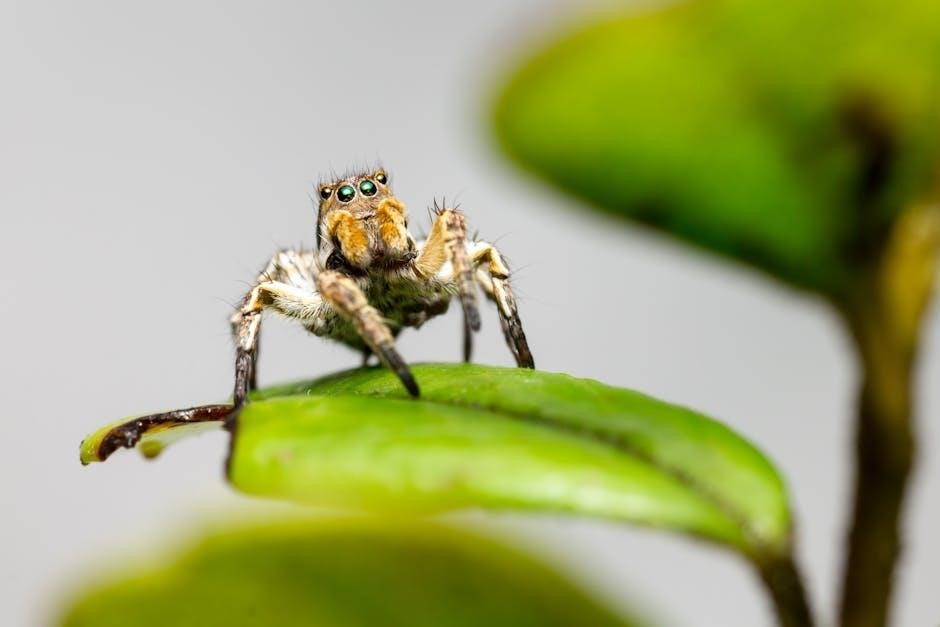Jumping spiders are active hunters, relying on their exceptional vision and agility to capture prey. Unlike web-spinning spiders, they actively pursue insects, making feeding in captivity unique.
1.1 Overview of Jumping Spiders as Hunters
These spiders are known for their bold hunting behavior, using ambush tactics and high-ground preferences to catch prey. Their ability to see clearly for several feet sets them apart.
1.2 Importance of Proper Feeding for Pet Jumping Spiders
Providing the right prey items, such as crickets or mealworms, is crucial. Proper feeding ensures healthy growth and avoids risks like overfeeding or starvation, keeping your pet thriving.
Jumping spiders are skilled predators, relying on their exceptional vision and agility to hunt. Unlike web-spinning spiders, they actively pursue prey, showcasing their bold and dynamic behavior. Their ability to see clearly for several feet allows them to detect and stalk prey effectively. These spiders often climb to high ground, using ambush tactics to jump onto unsuspecting insects. Their hunting strategy is both efficient and fascinating, making them unique among arachnids. This active approach to feeding is crucial for their survival in both the wild and captivity.
Proper feeding is essential for the health and survival of pet jumping spiders. Improper feeding can lead to malnutrition, stunted growth, or even starvation. Jumping spiders require a diet rich in protein from live insects like crickets or mealworms. Overfeeding can cause obesity, while underfeeding may weaken the spider. A balanced feeding schedule ensures optimal health, vitality, and longevity. Providing the right prey size and frequency is crucial to meet their nutritional needs and prevent potential health issues.
Understanding Jumping Spider Feeding Habits in the Wild
Jumping spiders actively hunt, using ambush tactics and high-ground preferences. They climb surfaces to jump on prey, relying on exceptional vision for detection and capture in their natural habitat.
2.1 Active Hunting Behavior
Jumping spiders do not spin webs and instead actively hunt for prey. They spend hours exploring their environment, using their exceptional vision to locate and stalk insects. Their ability to see clearly for several feet allows them to detect movement and approach prey stealthily. This hunting strategy is energy-intensive, requiring constant movement and quick reflexes to catch prey effectively in the wild.
2.2 Ambush Tactics and High-Ground Preferences
Jumping spiders often adopt ambush tactics, climbing to high ground such as branches or elevated surfaces to spot prey. From these vantage points, they can leap onto unsuspecting insects below. This strategy provides both safety from predators and access to small prey. Their exceptional vision allows them to detect movement and calculate precise jumps, making them efficient hunters. High-ground preferences are a key adaptation, enabling them to thrive in various environments by leveraging their agility and keen eyesight.
2.3 Vision and Prey Detection Abilities
Jumping spiders possess exceptional vision, allowing them to see clearly for several feet. This unique ability helps them detect prey from a distance and recognize potential threats. Their eyes are structured to detect movement and objects, enabling precise hunting. This advanced vision is crucial for their active hunting style, as they rely on sight rather than webs to capture prey. Their ability to detect vibrations and air currents further enhances their prey detection skills, making them highly efficient hunters in their natural habitat.
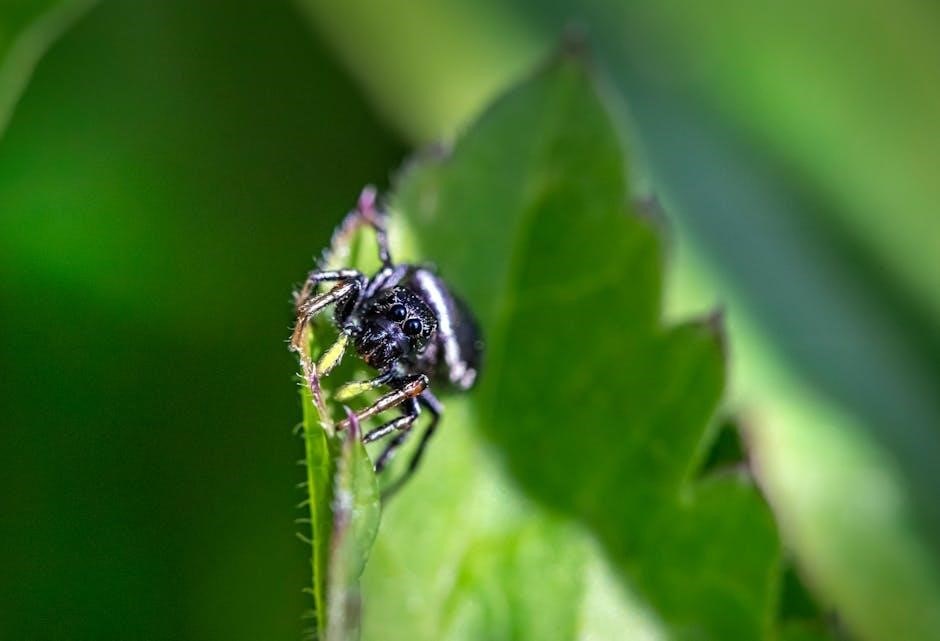
Feeding Jumping Spiders in Captivity
Feeding jumping spiders in captivity requires replicating their natural hunting behavior. Provide live prey like crickets or mealworms, ensuring they are appropriately sized. Use tweezers to offer food, mimicking their active hunting style. Maintain a clean environment and avoid overfeeding. Proper feeding techniques help keep your pet jumping spider healthy and thriving in its enclosure.
3.1 Differences from Wild Feeding Habits
In captivity, jumping spiders lack the vast space and diverse prey available in the wild. They cannot ambush prey from high ground or hunt continuously. Captive feeding relies on providing appropriate prey items like crickets or mealworms, often via tweezers, to simulate their natural hunting behavior. This method ensures they receive adequate nutrition despite the limited environment. Proper feeding techniques help maintain their health and activity levels in captivity.
3.2 Creating a Suitable Environment for Feeding
Jumping spiders thrive in enclosures that mimic their natural hunting grounds. A spacious, well-ventilated environment with substrate and visual barriers allows them to exhibit ambush behaviors. Maintain moderate humidity and temperature levels to ensure comfort. Feeding areas should be clear of obstacles to facilitate easy prey access. Providing a natural light-dark cycle can also enhance their feeding behavior; A clean, stress-free environment promotes healthy digestion and active hunting instincts in captivity.
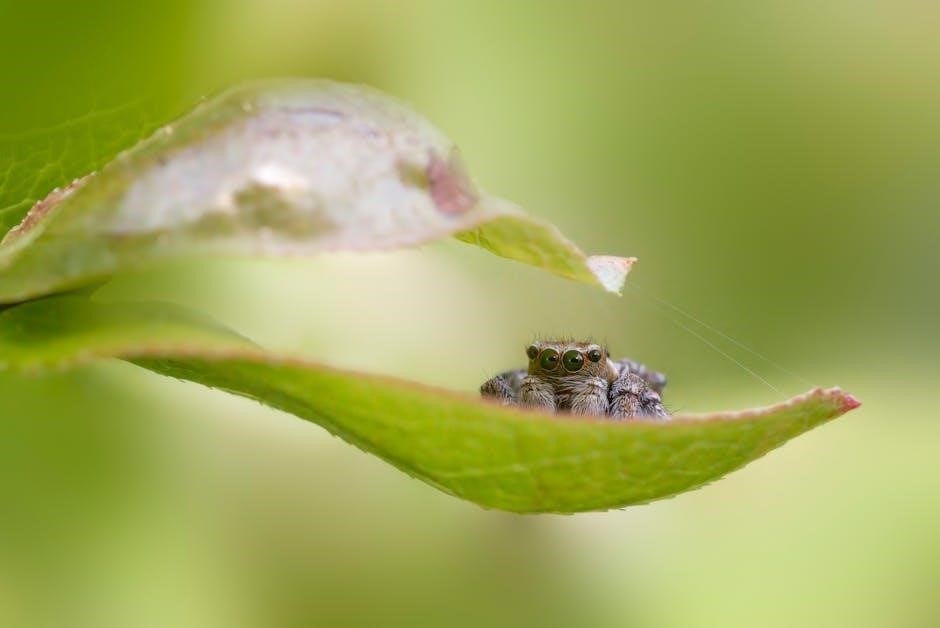
Appropriate Prey Items for Jumping Spiders
Jumping spiders primarily feed on small insects like crickets, mealworms, and fruit flies. These prey items provide essential nutrients for growth and energy, mimicking their wild diet.
4.1 Suitable Insect Prey (Crickets, Mealworms, Fruit Flies)
Crickets, mealworms, and fruit flies are ideal prey for jumping spiders. Crickets provide robust nutrition, while mealworms are high in protein. Fruit flies are perfect for smaller spiders. Ensure prey sizes don’t exceed 1.5 times the spider’s abdomen to avoid harm. Avoid wild insects due to potential pesticides. Live prey is preferred, but pre-killed options work if properly presented. Gut-loading prey with nutritious foods enhances dietary value for the spider, ensuring optimal health and growth.
4.2 Size Recommendations for Prey
Prey size is critical for jumping spiders. It should not exceed 1.5 times the spider’s abdomen width to prevent harm. Juvenile spiders need smaller prey, like pinhead crickets or fruit flies, while adults can handle larger insects like mealworms or medium-sized crickets. Proper sizing ensures safe consumption and prevents choking or stress. Avoid oversized prey, as it can injure the spider during feeding. Always observe your spider’s size and appetite to select appropriate prey, ensuring a balanced and safe diet for optimal health.
4.3 Avoiding Prey That May Harm the Spider
When feeding jumping spiders, it’s crucial to avoid prey that could cause harm. Wild insects may carry pesticides or parasites, risking the spider’s health. Additionally, certain prey, like large or aggressive insects, can fight back and injure the spider. Avoid offering prey with sharp edges or those that are too active, as they may cause stress or physical harm. Stick to captive-bred insects and ensure prey size is appropriate to prevent any potential risks during feeding sessions.
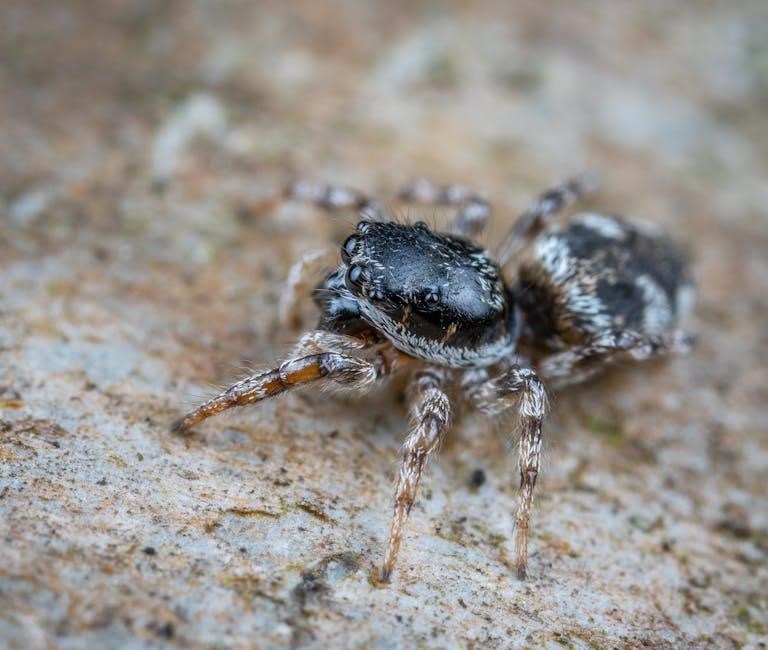
Feeding Techniques and Methods
Common feeding techniques include offering live prey, pre-killed prey, or using tweezers to present food directly. Live prey stimulates natural hunting behavior, while pre-killed prey ensures safety and convenience.
5.1 Live Prey Feeding
Live prey feeding mimics a jumping spider’s natural hunting behavior, promoting mental and physical stimulation. It involves releasing live insects like crickets or fruit flies into the enclosure, allowing the spider to actively pursue and capture its food. This method is particularly effective for encouraging natural instincts and ensuring the spider receives a nutritious meal. Live prey should be appropriately sized to prevent overwhelming the spider and to minimize the risk of the prey attacking the spider. Feeding tweezers can be used to gently guide the prey, ensuring the spider can easily locate and capture it. This approach also helps in monitoring the spider’s feeding behavior and overall health, making it a preferred choice for many keepers. Live prey feeding is especially beneficial for young or picky eaters, as it stimulates their natural hunting reflexes and ensures they receive adequate nutrition for growth and development. Additionally, it allows owners to observe their spider’s unique feeding techniques, which can vary between individuals. Properly managing live prey feeding is essential to maintain a balanced and healthy diet for pet jumping spiders. By providing live prey, owners can create an environment that closely replicates the spider’s natural feeding habits, leading to a happier and healthier pet. This method also reinforces the bond between the owner and the spider, as it becomes an interactive and educational experience. Overall, live prey feeding is a fundamental and effective technique in the care and feeding of jumping spiders, offering numerous benefits for both the spider and the keeper.
5.2 Pre-Killed Prey Feeding
Pre-killed prey feeding offers convenience for spider keepers, using freshly thawed or refrigerated insects like mealworms or flies. This method ensures prey remains nutritious and safe, as live insects may harm the spider. Tweezers are often used to present the prey, allowing the spider to approach and feed naturally. Pre-killed prey should be small enough for the spider to manage easily, avoiding overwhelming it. This method is ideal for busy owners, providing a stress-free feeding experience while maintaining the spider’s dietary needs. It also prevents live prey from potentially injuring the spider, ensuring a safe and controlled feeding process. While it lacks the stimulation of live prey, pre-killed feeding is a practical alternative for consistent nutrition. Proper storage and handling of pre-killed prey are crucial to maintain its quality and safety for the spider. This method is particularly useful for spiders that are picky eaters or for owners who prefer a hassle-free feeding routine. By offering pre-killed prey, owners can ensure their jumping spider receives a balanced diet without the risks associated with live insects. This approach also allows for precise control over portion sizes, helping to prevent overfeeding or underfeeding. Overall, pre-killed prey feeding is a reliable and efficient way to meet the nutritional needs of pet jumping spiders, combining convenience with care.
5.3 Using Tweezers for Feeding
Using tweezers for feeding jumping spiders allows for precise control and minimizes stress on the spider. This method is ideal for offering pre-killed prey or live insects that are too small to move. Gently place the prey near the spider using clean tweezers, ensuring the spider can approach without feeling threatened. This technique is particularly useful for captive care, as it mimics natural hunting behaviors while providing a safe and controlled feeding environment. Tweezers also help prevent prey from escaping or causing harm to the spider. Regular cleaning of the tweezers is essential to maintain hygiene and prevent the transfer of bacteria. This method is especially handy for owners who prefer a hands-on yet non-invasive feeding approach, ensuring the spider’s dietary needs are met effectively. It also allows for better observation of the spider’s feeding behavior, helping owners monitor its health and appetite. By using tweezers, owners can create a stress-free feeding experience for their pet jumping spiders, promoting a healthy and thriving environment.
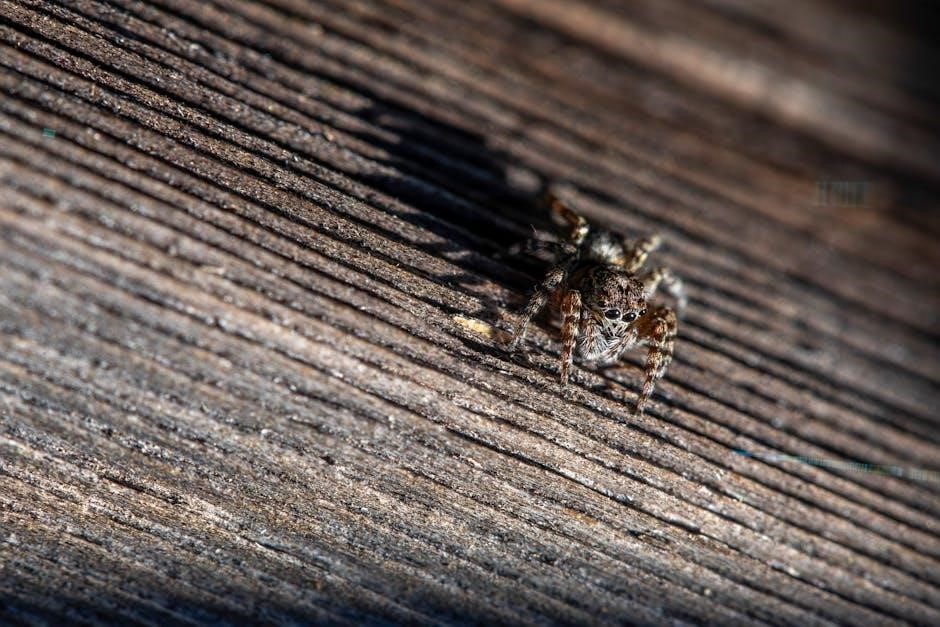
Feeding Schedule and Frequency
Juvenile jumping spiders require feeding every one to two days, while adults can be fed every two to three days. Adjust frequency based on age and appetite.
6.1 Feeding Frequency for Juvenile Jumping Spiders
Juvenile jumping spiders require more frequent feeding to support rapid growth. Feed them every 1-2 days, ensuring they receive sufficient nutrients for development. Monitor their appetite and adjust accordingly.
6.2 Feeding Frequency for Adult Jumping Spiders
Adult jumping spiders typically require feeding every 2-3 days, as they have slower growth rates compared to juveniles. Offer prey items like crickets or mealworms, ensuring portion sizes match their needs. Overfeeding can lead to obesity, so moderation is key. Adults have robust appetites but maintaining a balanced feeding schedule supports optimal health and activity levels.
Nutritional Considerations
Ensure calcium and vitamin supplementation for strong exoskeletons and vitality. Provide varied prey to meet dietary needs, avoiding overfeeding to prevent obesity and maintain optimal health.
7.1 Calcium and Vitamin Supplementation
Calcium and vitamin supplementation are essential for jumping spiders’ health, supporting exoskeleton development and overall vitality. Dusting prey items with calcium powder regularly, especially for growing juveniles, ensures strong growth. Vitamins can be added to prey occasionally to provide a balanced diet. Avoid over-supplementation, as it may harm the spider. A varied and nutrient-rich diet, combined with proper supplementation, promotes optimal health and energetic behavior in pet jumping spiders.
7.2 Avoiding Over-Feeding and Obesity
Avoiding over-feeding is crucial, as jumping spiders can become obese, leading to health issues. Monitor feeding frequency and prey size to prevent excessive weight gain. A spider’s abdomen should remain firm and rounded, not overly swollen. Overfeeding can reduce mobility and lifespan. Ensure prey items are proportionate to the spider’s size, and avoid leaving uneaten prey for extended periods. Balance feeding schedules to maintain a healthy, active metabolism and prevent obesity-related complications.
7.3 Importance of Prey Variety
Offering a variety of prey ensures a balanced diet for jumping spiders, preventing nutritional deficiencies. Rotate prey like crickets, mealworms, and fruit flies to provide diverse nutrients. Different insects offer varying protein and calcium levels, essential for growth and health. Variety also prevents boredom and stimulates natural hunting behavior. Avoid reliance on a single food source, as it may lead to incomplete nutrition. Gut-loading prey with nutrient-rich foods before feeding can further enhance the spider’s dietary intake, promoting overall well-being and vitality.
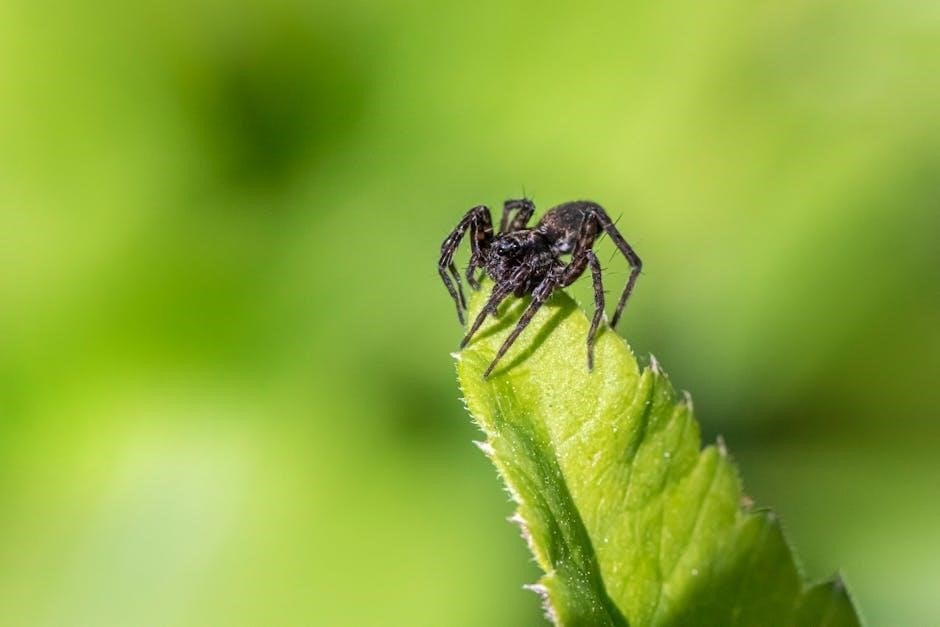
Housing and Feeding Environment
Jumping spiders require adequate space to hunt and thrive. Proper humidity and temperature maintenance are essential for their health. Incorporate plants or substrate to mimic their natural habitat.
8.1 Enclosure Size and Space Requirements
Jumping spiders need spacious enclosures to mimic their natural hunting environment. A minimum enclosure size of 5-7 inches in height and 3-5 inches in width is recommended. This allows them to climb and jump effectively, which is essential for their physical and mental well-being. Providing adequate space ensures they can exhibit their active hunting behavior and prevents stress. The enclosure should also be well-ventilated to maintain optimal humidity levels. Avoid overcrowding, as jumping spiders are territorial and may fight if kept together.
8.2 Maintaining Proper Humidity and Temperature
Maintaining proper humidity (60-70%) and temperature (70-80°F) is vital for jumping spiders. Mist the enclosure 2-3 times weekly to retain moisture. A slight drop in humidity at night mimics their natural habitat. Avoid extreme temperatures, as they can stress the spider. Provide a temperature gradient for thermoregulation, ensuring optimal metabolic function. Proper environmental conditions support digestion, activity, and overall health, preventing issues like dehydration or slowed growth. Consistency is key to creating a stable, thriving environment for your pet jumping spider.
Handling and Feeding
Handle jumping spiders gently, ensuring calm movements. Use tweezers to offer prey, allowing the spider to climb onto the tool. This method minimizes stress and promotes feeding.
9.1 Safe Handling Practices
When handling jumping spiders, move slowly and remain patient. Sudden movements can stress the spider. Use a clean, dry pair of tweezers to gently guide the spider onto your hand or a feeding tool. Allow the spider to climb onto the tweezers willingly to avoid causing anxiety. Never handle the spider by its legs, as this can cause injury. Place the spider back into its enclosure carefully after handling. Feeding during handling can help distract the spider, reducing stress and making the process more efficient.
9.2 Feeding During Handling Sessions
Feeding during handling can help reduce stress and create a positive association for the spider. Offer prey like fruit flies or small crickets using tweezers, allowing the spider to focus on eating. Move slowly and carefully to avoid startling the spider. This method can make handling sessions more enjoyable and less stressful for both you and the spider, fostering trust and easing the feeding process.
Molting and Feeding
Molting is a critical phase where spiders shed their skin to grow. During this time, they stop eating, so feeding should be paused to prevent stress.
10.1 Recognizing Molting Signs
Recognizing molting signs is crucial for proper care. Look for your jumping spider slowing down, withdrawing from interactions, or showing lethargy. They may stop eating and display changes in color or pattern, as their skin begins to split. Some spiders will spin a protective web or remain still for extended periods. Observing these behaviors helps you identify when molting is imminent, ensuring you can adjust their feeding schedule appropriately. This period is vital for their growth and health.
10.2 Withholding Food During Molting
Withholding food during molting is essential, as jumping spiders cannot eat while shedding their skin. Attempting to feed during this period can cause harm or stress. Ensure your spider has access to water but avoid offering prey. Molting is a natural process, and withholding food temporarily supports their health. Resume feeding once the spider has fully emerged and appears active. This practice prevents complications and ensures a successful molt, promoting overall well-being.
Monitoring Feeding Success
Monitor your jumping spider’s feeding behavior and digestion. Ensure the spider consumes prey fully and appears healthy post-feeding. A well-fed spider will have a rounded abdomen and active demeanor.
11.1 Observing Feeding Behavior
Observe your jumping spider during feeding to ensure it actively hunts and consumes prey. Note if the spider approaches the prey confidently and captures it efficiently. A healthy spider will display quick reflexes and a strong feeding response. If the spider shows hesitation or disinterest, it may indicate stress or illness. Monitoring these behaviors helps assess the spider’s overall well-being and feeding effectiveness, ensuring proper care and nutrition are being met. Adjust feeding techniques or prey items if necessary based on observations.
11.2 Checking for Proper Digestion and Health
After feeding, monitor your jumping spider for signs of proper digestion. A healthy spider will have a rounded abdomen and exhibit active behavior. Look for droppings, which indicate successful digestion. If the spider appears lethargic or its abdomen is discolored, it may signal poor digestion or underlying health issues. Ensure prey items are appropriately sized and varied to promote optimal health. Regular observation helps maintain your spider’s well-being and ensures its digestive system functions correctly.
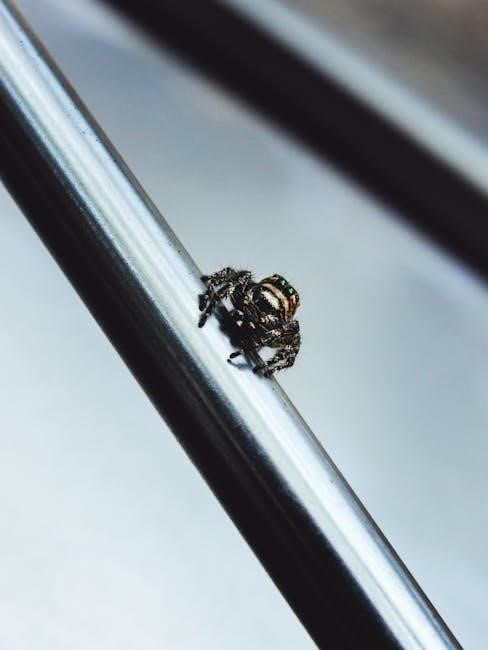
Common Feeding Mistakes to Avoid
Overfeeding, improper prey size, and using tweezers roughly can harm jumping spiders. Ensure prey is appropriately sized and avoid feeding during molting to prevent health issues.
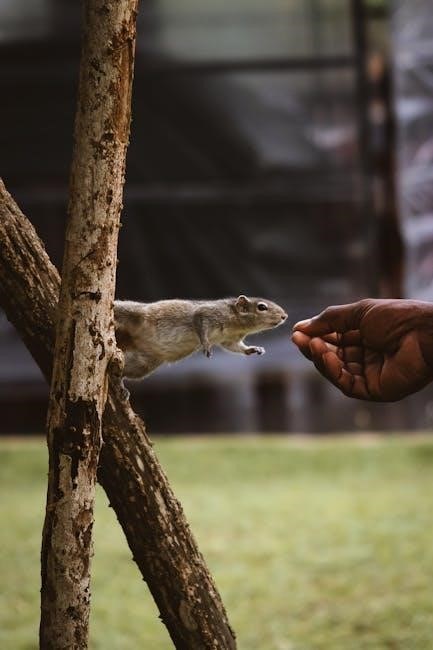
12.1 Overfeeding and Underfeeding Risks
Overfeeding can lead to obesity and health issues in jumping spiders, while underfeeding may cause malnutrition. Recognizing signs like an enlarged abdomen or lethargic behavior is crucial. Maintaining a balanced feeding schedule ensures optimal health and prevents these risks, keeping your pet active and thriving. Proper portion control and observation are key to avoiding these common feeding mistakes, ensuring longevity and well-being for your jumping spider.
12.2 Improper Prey Size Selection
Feeding prey that is too large can harm jumping spiders, as it may cause injury or stress. Conversely, prey that is too small may not provide adequate nutrition. Ensuring prey items are appropriately sized relative to the spider’s body is essential for healthy digestion and growth. Prey should not exceed 1.5 times the spider’s abdomen width. Avoiding wild insects, which may contain pesticides, is also crucial for the spider’s safety and well-being.
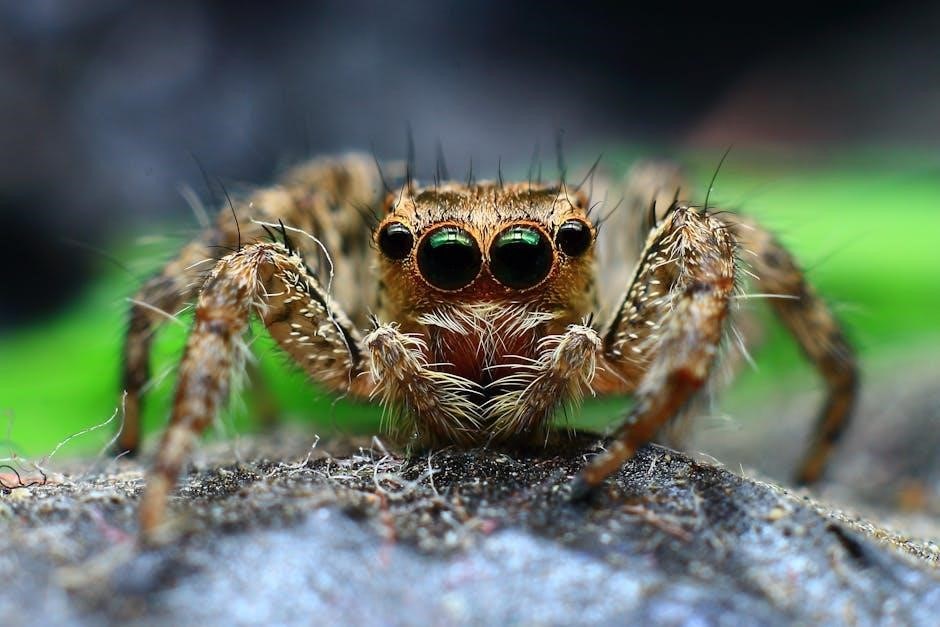
Advanced Feeding Tips for Experienced Keepers
13.1 Power Feeding for Growth Acceleration
Power feeding involves increasing temperature and feeding frequency to accelerate growth. This method boosts metabolism and encourages faster development, but must be applied carefully to avoid stressing the spider.
Power feeding involves increasing feeding frequency and temperature to accelerate growth, particularly in juvenile jumping spiders. This method boosts metabolism, promoting faster development and larger size. However, it must be done cautiously to prevent stress or obesity.
Experienced keepers use this technique to enhance growth rates, but it requires careful monitoring. Ensure prey size and quantity align with the spider’s needs to avoid overfeeding and maintain health.
13.2 Using Gut-Loaded Prey for Enhanced Nutrition
Gut-loading prey involves feeding insects nutrient-rich diets before offering them to your jumping spider. This enhances the spider’s nutrition by transferring beneficial vitamins and minerals from the prey.
Feeding prey items like crickets or mealworms high-quality foods increases their nutritional value. This method is particularly useful for ensuring juvenile or gravid spiders receive optimal nutrients for growth and health.
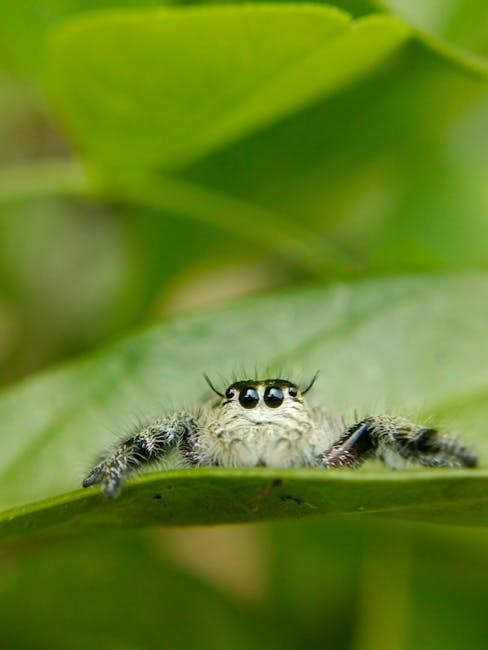
Feeding Challenges and Solutions
Common challenges include picky eaters and managing feeding during vacations. Solutions involve offering prey variety, using tweezers for live feeding, and ensuring prey size is appropriate.
14.1 Dealing with Picky Eaters
Some jumping spiders can be selective eaters, refusing certain prey. To address this, offer a variety of prey items like crickets, mealworms, or fruit flies. Live prey often stimulates their hunting instincts. If your spider ignores prey, try gently offering it with tweezers or allowing the prey to move naturally. Ensure prey is appropriately sized and fresh. Patience is key, as some spiders may take time to accept new food sources. Avoid forcing food, especially during molting periods, when appetite naturally decreases.
14.2 Managing Feeding During Vacation
When planning a vacation, ensure your jumping spider’s feeding needs are met. If your trip is short, your spider may not need food, as they can go weeks without eating. For longer absences, consider automated feeders or ask a trusted person to check in. Provide small, live prey like juvenile crickets or fruit flies, as they are less likely to disturb the spider. Avoid overfeeding before leaving, as this can stress the spider. Ensure proper humidity and temperature levels are maintained during your absence.
Proper feeding is vital for jumping spiders’ health. Provide diverse prey, maintain optimal environments, and avoid overfeeding; With care, your pet will thrive and remain active.
15.1 Summary of Key Feeding Guidelines
Feed jumping spiders live prey like crickets or mealworms, ensuring prey size is appropriate. Maintain proper humidity and temperature, and avoid overfeeding to prevent health issues. Provide varied diet for optimal nutrition, and monitor feeding behavior to ensure success. Following these guidelines ensures your jumping spider remains healthy and active.
15;2 Final Tips for Successful Jumping Spider Care
Observe your spider’s behavior to tailor feeding and care. Ensure a clean, well-ventilated enclosure with proper humidity and temperature. Provide varied prey for balanced nutrition and avoid overfeeding. Handle gently and briefly to minimize stress; Monitor molting cycles and withhold food during this time. Stay patient and attentive to your spider’s needs for a thriving, happy pet. Regularly research and adapt care practices to ensure the best outcomes for your jumping spider.
